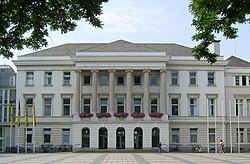
Back Krefeld Afrikaans Krefeld AN كريفلد Arabic كريفيلد ARZ Krefeld AST Krefeld AVK Krefeld Azerbaijani کرفلد AZB Крефельд Bashkir Krefeld BAN
Krefeld
Krieëvel (Limburgish) | |
|---|---|
 City Hall | |
| Coordinates: 51°20′N 06°34′E / 51.333°N 6.567°E | |
| Country | Germany |
| State | North Rhine-Westphalia |
| Admin. region | Düsseldorf |
| District | Urban district |
| Government | |
| • Lord mayor (2020–25) | Frank Meyer[1] (SPD) |
| Area | |
| • Total | 137.68 km2 (53.16 sq mi) |
| Elevation | 39 m (128 ft) |
| Population (2023-12-31)[2] | |
| • Total | 228,550 |
| • Density | 1,700/km2 (4,300/sq mi) |
| Time zone | UTC+01:00 (CET) |
| • Summer (DST) | UTC+02:00 (CEST) |
| Postal codes | 47701-47839 |
| Dialling codes | 02151 |
| Vehicle registration | KR |
| Website | www |

Krefeld (/ˈkreɪfɛld, -ɛlt/ KRAY-feld, -felt,[3][4][5][6] German: [ˈkʁeːfɛlt] ; Limburgish: Krieëvel [ˈkʀiə˦vəl]), also spelled Crefeld until 1925 (though the spelling was still being used in British papers throughout the Second World War),[7] is a city in North Rhine-Westphalia, Germany. It is located northwest of Düsseldorf, its center lying just a few kilometers to the west of the river Rhine; the borough of Uerdingen is situated directly on the Rhine. Because of its economic past, Krefeld is often referred to as the "Velvet and Silk City". It is accessed by the autobahns A57 (Cologne–Nijmegen) and A44 (Aachen–Düsseldorf–Dortmund–Kassel).
Krefeld's residents now speak Hochdeutsch, or standard German, but the native dialect is a Low Franconian variety, sometimes locally called Krefelder Platt, Krieewelsch Platt, or sometimes simply Platt. The Uerdingen line isogloss, separating general dialectical areas in Germany and neighboring Germanic-speaking countries, runs through and is named after Krefeld's Uerdingen district, originally an independent municipality.
- ^ Wahlergebnisse in NRW Kommunalwahlen 2020 Archived 17 May 2022 at the Wayback Machine, Land Nordrhein-Westfalen, accessed 19 June 2021.
- ^ "Bevölkerung der Gemeinden Nordrhein-Westfalens am 31. Dezember 2023 – Fortschreibung des Bevölkerungsstandes auf Basis des Zensus vom 9. Mai 2011" (in German). Landesbetrieb Information und Technik NRW. Retrieved 20 June 2024.
- ^ "Krefeld". The American Heritage Dictionary of the English Language (5th ed.). HarperCollins. Retrieved 23 August 2019.
- ^ "Krefeld". Collins English Dictionary. HarperCollins. Archived from the original on 23 August 2019. Retrieved 23 August 2019.
- ^ "Krefeld". Lexico US English Dictionary. Oxford University Press. Archived from the original on 3 August 2020.
- ^ "Krefeld". Merriam-Webster.com Dictionary. Merriam-Webster. Retrieved 23 August 2019.
- ^ Staff. "The Western Front". The Observer. Vol. 248 No. 7, 737. London. p. 9, col. 3. Archived from the original on 24 January 2020. Retrieved 24 January 2017.




